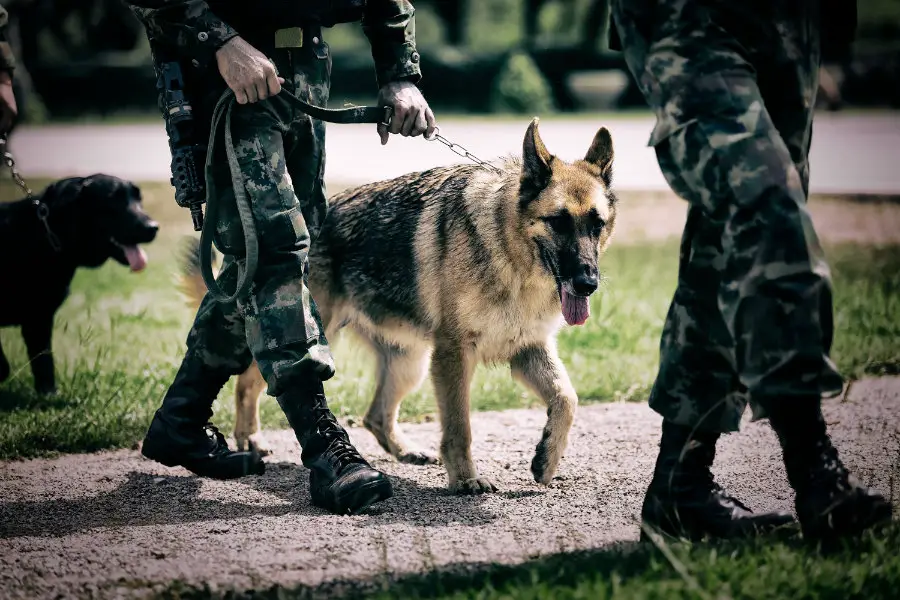German Shepherds have long been sought-after dogs in the police force. When you think of a K9 Unit, most likely you’re picturing a German Shepherd. All breeds of German Shepherds are hard-working and loyal, but some are more so than others.
The most common breeds of German Shepherds used as police dogs are the East German working line and the Czech working line dogs. The police force will occasionally also use West German working line German Shepherds as part of their team.
The working line German Shepherd dogs play an essential role in the police force and military duties. Their popularity increased after the World Wars, which resulted in a show line of German Shepherds to be developed, too. The show line of dogs is more suitable for family pets, but let’s have an in-depth look at the German Shepherd varieties.

What Are The Different Types Of German Shepherds?
German Shepherds were originally bred as working dogs, which lead to the working line of German Shepherds. As the breed grew in popularity, a show line of dogs was developed. There are two types of show line German Shepherds and three types of working line German Shepherds.
American Show Lines
As the German Shepherd breed became more and more popular globally, the North American people took notice. By the 1970s, the American show line of German Shepherds was created.
American show lines, or a variation, are probably what you’ll find in a German Shepherd household if you live in the United States or Canada. These dogs are mainly bred for showing and don’t really have the temperament to be a working dog.
In appearance, these dogs are heavier and larger than the other types of German Shepherds. In contrast to this, their heads are smaller, and their bones are thinner than the other varieties. The rear angulation is also more pronounced in the American show lines.
The American show line German Shepherd dogs will fit in very well with less active family-orientated households. Although they are not suitable as protective dogs, they still require some exercise and tasks while being laid back enough to enjoy as a family pet.
There are exceptions, but these dogs are not usually used as police dogs. They are simply not strong enough.
West German Show Lines
The West German show line German Shepherd is likely going to have you looking back in admiration. That is all subjective, of course, but these dogs are known to be the lookers of the bunch.
It’s not all about the looks with this variety of the breed, though. These dogs are bred under stringent German Shepherd breeding standards (called the SV standard). They must comply with specific health certifications for their hips and elbows to be legitimate for breeding.
Even though the West German show line adheres to standards and health regulations, these dogs still suffer from weak hips. Nevertheless, as a family pet, the West German show lines are ideal for companionship and protection. They can be utilized as working dogs, and they need a lot of social interaction and exercise.
West German Working Lines
The West German Woking Line dogs are the closest variation to the vision and aim of the German Shepherd’s original breeder, Max von Stephanitz. Bred under the strict SV standards, these dogs conform to the correct working structure, a reliable temperament, and superb working ability.
Active families enjoy the addition of these dogs to the household. They seek stimulation and exercise but have an easy-going demeanor. However, bringing these dogs into the family as a companion requires some experience in owning a dog.
Bred as a working line dog, these German Shepherds are driven and focussed. They are marvelous workers and can easily be trained for positions in law enforcement or security. These dogs sometimes still tend to have health issues because the health evaluations in West Germany aren’t as strict as in East Germany.

East German Working Lines
The Berlin wall created such a divide in Germany that led to the East German working line German Shepherd to be preserved very well. The breeding of these dogs was isolated and particularly regulated. These dogs were developed after World War II from the dogs that survived the war.
Firm control of the bloodline by the Eastern Germany government ensured that these dogs have very few health issues, phenomenal genetics, and outstanding temperament. They are famous for their correct working structure and have large heads and bones.
These healthy dogs were bred to be protective dogs and work for the police force and the Military. Testing is done on each puppy before it is sold to someone, ensuring no health issues. They have supreme intellect and very high stamina, making them ideal for long working days.
Their drive, however, does vary. A less active East German working line can be a good family pet.
Czech Working Lines
The Czech working lines, also known as the Czechoslovakian Shepherd, are pretty unique; these dogs can all be narrowed down to one kennel, initially managed by the Czech Army. They were initially bred as border control dogs.
Breeding started in 1955 in the communist Czech Republic with the primary aim to be working dogs. The dogs originated from the East German working line bloodline. The Czech and East German working lines may share similar origins and characteristics, but they are not the same.
The Czech working line tends to be smaller with a higher drive than its West and East German counterparts. When East and West Germany reunited in 1989, their popularity increased and perhaps even surpassed that of the East German working line.
Why Do The Police Make Use Of German Shepherds?
When you picture a police dog, a German Shepherd comes to mind. They are synonymous with the police force – and for a good reason. German Shepherds are fast learners, knowledgeable, work well under pressure, and manage the stress associated with police duties.
Initially, German Shepherds were bred to be working dogs. The founding breeder, Max von Stephanitz, started with selective breeding in 1889, explicitly focussing on traits like intelligence, loyalty and persistence.
In 1910, Von Stephanitz’s dogs were tested by a few German police forces for tactic and protective work, as well as tracking. After very successful results, the dogs were incorporated into police and military jobs in Europe.
There are undoubtedly other dog breeds that would be fit for police duty, but very few of them have such a good balance as the German Shepherd. German Shepherds are dogs with efficiency in all features necessary for the job of a police dog.
What Role Did German Shepherds Play In The History Of Dogs In Duty?
Since the 1900s, when the breed became intensely involved in the European police force and Military, German Shepherds have been widely utilized in the line of duty. Von Stephanitz couldn’t have had better timing.
In World War I, they were used to perform some battlefield tasks within the German Military. Their intelligence and obedience made them good companions to the soldiers, some dogs even playing crucial roles in leading soldiers to safety and to medical attention when they were injured.
During World War II, the U.S. Military also deployed German Shepherds. The dogs were mainly used as messengers for the U.S. soldiers, apart from being used as guards and search and rescue dogs.
After World War II, the dogs were present in the Korean War and the Vietnam War. They had a more prominent role in the Vietnam War, acting as sentries and later also as scout dogs.
German Shepherds continue to play a vital role in the police force and military programs. They are valuable members of the teams and are protected by laws to guarantee a dignified retirement from the police force or Military.
Final Thoughts
German Shepherds’ overall combination of endurance, athleticism, courage, intelligence and adaptability make them the most commonly used dogs in the police force and the Military.
German Shepherds were used throughout history in many wars and trying times. The rise in their popularity after World War II started the expanse in the variety of the breed. The working line and the show line of German Shepherds developed.
The working line German Shepherds are bred specifically to work hard, be obedient, and endure long days. East German and Czech working line German Shepherds are favored because of their strict and outstanding breeding standards, although West German working line dogs are also used in some cases.
The show line German Shepherds were bred to be less active and fit into a household more conveniently. These dogs struggle with health issues because of extreme rear angulation. They are also not as strong as the working line dogs and have a less fierce temperament, making them less likely to be used as police dogs.
